Adapting the indoor environment and implementing alternative methods of efficiency were the center of discussion at Danfoss’s 19th EnVisioneering Symposium, titled, “Building and Energy Infrastructure,” held in June in Washington, D.C. The roundtable discussion joined HVAC OEMs, consultants, and contractors with advocacy and utility groups, and authorities in research and policy to examine the opportunity of investment in next-generation energy infrastructure for commercial buildings.
“We’re in the midst of crossing to a whole-systems way of thinking in our buildings,” said Robert Wilkins, vice president, public affairs, Danfoss. “There is hope that low-cost natural gas is creating a new industrial revolution, putting us on a trajectory of energy independence.”
A Whole-Systems Approach
In 2010, the U.S. consumed 97.8 quads of energy, accounting for 19 percent of total global consumption, according to the U.S. Department of Energy’s (DOE) Buildings Energy Data Book. In that year, the building sector accounted for about 41 percent of primary energy consumption, 44 percent more than the transportation sector and 36 percent more than the industrial sector.
Many in attendance believe a widespread shift to whole-buildings systems efficiency offers the first step toward the transformation in buildings parallel to what’s transpired in other industries such as telecommunications and logistics. Many members of the group estimated that a 30 percent improvement in energy efficiency would generate net positive annual cash flow of $65 billion for households, businesses, and governments.
Presenters Richard Lord, engineering fellow, Carrier Corp., and Drake Erbe, vice president of market development, Airxchange Inc., further examined the changing paradigm of the whole-building systems approach at the event, detailing the status of energy-efficiency improvements and standards for buildings, why America needs to change, and alternative approaches that could provide future solutions.
“As an industry, we face significant challenges and the old approaches used since the 1970s may not be the best approach,” said Lord. “To address HVACR as a system requires tools and procedures that are not fully developed. The industry has tools but there is little validation, and hundreds of assumptions are required today to run these tools. Modeling tools and procedures that can accurately model the building as a system are necessary.
“Equipment modeling requires HVACR models that do not exist. Studies I have done show that existing models are not very accurate and do not represent the equipment we are now producing. The development of HVAC equipment models for building models is currently a manual process and very time consuming. Standards like ASHRAE 205 are trying to improve this, but need support.”
Lord identified several initiatives that could help propel the industry toward the adoption of a whole-systems approach, including the need to identify industry standard systems and efficiency system metrics; the proposal of part-load or annualized metrics where none currently exist; expanding the use of subsystem ratings similar to guideline V for other systems; developing guidelines and best-practice procedures; and forming partnerships with other industry organizations including ASHRAE, the Consortium for Energy Efficiency (CEE), Title 24, and more.
Lord is optimistic that the industry will achieve these goals, but admitted it will take time and cooperation. “The data that manufacturers provide will have to be expanded, which will take considerable effort and is complicated by existing certification programs,” he said. “Standards will have to change from a prescriptive approach to a systems approach, and the U.S. is currently moving more toward the prescriptive approach.
“These changes will likely require changes in federal law and we will need to address existing buildings — and the continued maintenance of all buildings — which is not being focused on at this point in time.”
Mick Schwedler, manager of HVAC applications and engineering, Trane, capped the discussion, addressing the changes that will be required by the people who own, operate, and occupy buildings, stating that, “We need to pick the right metric to drive the right behavior.”
Energy Usage
Several attendees shared that energy-efficiency investments provide the greatest future return on investment. According to the U.S. Navy, one GW of renewable energy is enough to power 250,000 homes, or a community the size of Orlando, Fla.
“Energy efficiency is a long-term investment, especially since we’re in a period of volatility. Making an investment for energy efficiency — specifically regarding natural gas — is a very good long-term investment prospect,” said Thomas W. Hicks, deputy assistant secretary f the Navy. “One of the things we’ve learned studying the marketplace is that energy efficiency is a wonderful stabilizer. By 2050, we’re talking in terms of 40-60 percent reductions in the use of energy through efficiency.”
As the price of natural gas continues to rise, so does interest in saving energy. “Natural gas is a game changer, but the reality is that the natural gas market is not one of the things that is changing,” said Hicks. “The focus remains on least-cost resources, which represent a major opportunity for savings, adds the opportunity to stabilize and reduce future prices, and reduces price volatility. These are all important things worth taking a look at.”
R. Neal Elliott, associate director of research, American Council for an Energy-Efficient Economy (ACEEE), said energy efficiency is an intelligent investment, deeming it a zero-emission energy resource.
“Energy efficiency reduces the demand for gas and can reduce U.S. energy usage by 42-59 percent by 2050,” he said. “It prevents outages and lowers the load and stress in the power-distribution network. It also reduces a utility’s exposure to fuel price volatility, diversifies energy resources across multiple small and moderate-sized projects, and reduces costs to rate payers.”
Stephen Selkowitz, group leader, windows and building envelopes, Lawrence Berkeley National Laboratory, said optimizing the building envelope in the context of whole-building performance requires a comprehensive, balanced program.
“To routinely deliver high-performance, low-energy buildings, we must find a balance between people, policy, market economics, technology, innovation, and process,” he said. “Without this balance, solutions are bound to fail.”
To achieve an energy balance for thermal comfort, Selkowitz referenced several advanced technologies, including automated shading, controls, cool coatings, daylight-redirecting, highly insulated windows, switchable coatings, and more. “Maximum performance requires full integration with all building systems — all intelligent control systems need to be explored,” he said. “Smart controllers must be able to consider task requirements, user preferences, interior conditions, weather conditions, load shedding, and more.”
Despite the cost to implement the aforementioned changes and considerations, Selkowitz acknowledged that energy efficiency is a worthwhile investment. “High-performance windows and building facades improve occupant comfort, satisfaction, and performance,” he said. “They also add value and reduce operating costs for the building owner and, for the planet, reduce greenhouse gas emissions and energy demand.”
Danfoss’s 20th EnVisioneering Symposium will examine the climate and energy nexus in commercial refrigeration, including refrigerant regulation and innovation. The event is scheduled for Sept. 11 in Baltimore. For more information, visit http://bit.ly/14Qu9lP.
Publication date: 8/5/2013
Want more HVAC industry news and information? Join The NEWS on Facebook, Twitter, and LinkedIn today!










